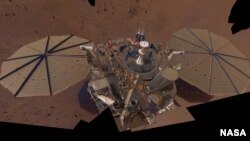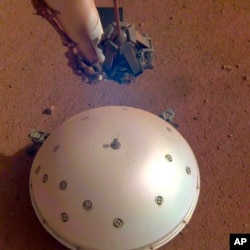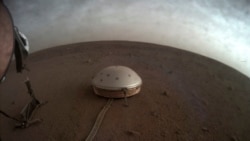Scientists say they have identified the two largest “marsquakes” ever recorded on the Red Planet.
A marsquake is a seismic event that happens on Mars. It is similar to earthquakes that happen on our planet.
The activity was recorded by a device called a seismometer. It is attached to the InSight lander, a spacecraft operated by the American space agency NASA.
The seismometer was designed to be extremely sensitive for the Martian environment. It aims to differentiate between seismic signals coming from inside Mars and activity coming from above the surface, such as wind or meteorite movements.
One of the marsquakes happened on August 25, 2021. It had a magnitude of 4.2. The other, on September 18, 2021, measured 4.1.
An international team, led by researchers from Britain’s University of Bristol, confirmed the seismic activity. The findings were recently reported in a study in the publication The Seismic Record.
A marsquake happens when soil on Mars is subjected to a buildup of pressure so great that it leads rock structures to break, explains ETH Zurich. ETH Zurich is a public research university in Zurich, Switzerland. Researchers from the university took part in the latest study.
The InSight lander brought the first seismometer to Mars in late 2018. It recorded its first marsquake in April 2019. Since then, it has recorded hundreds of marsquakes.
But examinations of the two reported in the study suggest they were largest yet to hit Mars. The researchers said the two marquakes were five times stronger than any others recorded before. They were also the first seismic events to happen on the planet’s far side from where the InSight lander sits.
The study notes that as of October 2021, records from InSight included nearly 1,000 seismic events. All of those happened on the side of Mars where the spacecraft operates, in an area called Elysium Planitia. NASA says that area sits just north of Mars’ equator and is the second largest volcanic area on the planet.
As the seismic activity was still being studied, NASA noted in a statement last September that it appeared the 4.2 marsquake happened about 8,500 kilometers from the InSight lander.
Both large marquakes happened in an area known as the “core shadow zone,” said a statement by the Seismological Society of America.
That is a part of Mars where some kinds of seismic waves cannot travel directly to InSight’s seismometer. This is because the waves get blocked or are otherwise affected by the planet’s core. The waves instead get “reflected at least once at the surface before traveling to the seismometer,” the society statement said.
“Recording events within the core shadow zone is a real stepping-stone for our understanding of Mars,” said Savas Ceylan, a researcher with ETH Zurich who helped lead the study. He added that the energy that travels within the core shadow of Mars has never been seismologically studied before.
The researchers say such seismic wave data can help them learn more about deeper layers within Mars, as well as the planet’s current seismic activity.
I’m Bryan Lynn.
Bryan Lynn wrote this story for VOA Learning English, based on reports from the Seismological Society of America, NASA and The Seismic Record.
We want to hear from you. Write to us in the Comments section, and visit our Facebook page.
________________________________________________________________
Words in This Story
seismic – adj. relating to or caused by an earthquake
meteorite – n. a piece of rock from outer space that has fallen to Earth’s surface
core – n. the center part of a planet
reflect – v. to send back or bounce off of something
stepping-stone – n. an event or experience helpful to reaching a goal
layer – n. one of several amounts of a substance, each on top of the other











